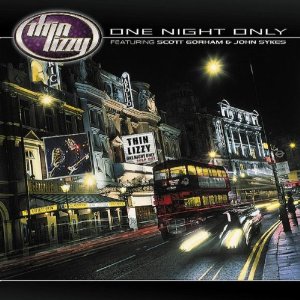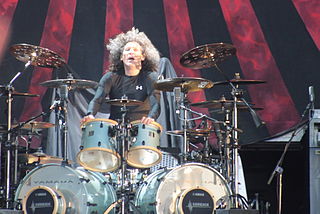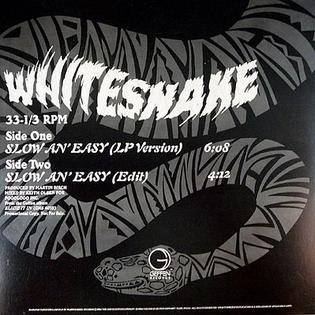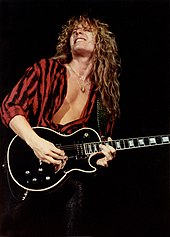
Whitesnake are an English hard rock band formed in London in 1978. The group was originally put together as the backing band for singer David Coverdale, who had recently left Deep Purple. Though the band quickly developed into their own entity, Coverdale is the only constant member throughout their history.

Thin Lizzy are an Irish hard rock band formed in Dublin in 1969. Thin Lizzy initially consisted of bass guitarist, lead vocalist and principal songwriter Phil Lynott, drummer Brian Downey, guitarist Eric Bell and organist Eric Wrixon, although Wrixon left after a few months. Bell left at the end of 1973 and was briefly replaced by Gary Moore, who himself was replaced in mid-1974 by twin lead guitarists: Scott Gorham, who remained with the band until their break-up in 1983, and Brian Robertson, who remained with the band until 1978 when Moore re-joined. Moore left a second time and was replaced by Snowy White in 1980, who was himself replaced by John Sykes in 1982. The line-up was augmented by keyboardist Darren Wharton in 1980. The singles "Whiskey in the Jar" (1972), "The Boys Are Back in Town" (1976) and "Waiting for an Alibi" (1979) were international hits, and several Thin Lizzy albums reached the top ten in the UK. The band's music reflects a wide range of influences, including blues, soul music, psychedelic rock and traditional Irish folk music, but is generally classified as hard rock or sometimes heavy metal.

Robert William Gary Moore was a Northern Irish musician. Over the course of his career, he played in various groups and performed a range of music including blues, blues rock, hard rock, heavy metal and jazz fusion.

David Coverdale is an English singer and songwriter best known as the founder and lead singer of hard rock band Whitesnake. He was also the lead singer of Deep Purple from 1973 to 1976, after which he released two solo studio albums White Snake and Northwinds before forming Whitesnake in 1978.

Blue Murder were an English rock band led by guitarist-vocalist John Sykes. The group was formed in 1987 following Sykes's dismissal from Whitesnake. The initial line-up was rounded out by bassist Tony Franklin and drummer Carmine Appice. In its nascent stage, vocalist Ray Gillen and drummer Cozy Powell were attached to the project. In 1989, Blue Murder released their self-titled debut album, which cracked the Billboard 200 chart and spawned a minor hit with "Jelly Roll". By the early 1990s, however, Blue Murder's music had fallen out of fashion with the popularity of grunge. Franklin and Appice left the band, while Sykes put together a new line-up and released Nothin' But Trouble in 1993. After a live album the following year, Blue Murder were dropped by their record label and broke-up. Since then there have been numerous attempts to reunite the band to no avail.

One Night Only is a live album by rock band Thin Lizzy, released in 2000. Thin Lizzy had reformed in 1994 for a series of gigs marking ten years since the band split in 1984. Latter-day Lizzy guitarist John Sykes now took the lead vocal while Marco Mendoza was recruited on bass. The venture was popular enough to be repeated but by the time this album came out, original drummer Brian Downey had decided the affair was too disorganised and retired from the group leaving none of the original trio remaining. Keyboardist Darren Wharton also quit around the time of this album's release. The band, led by Sykes and Scott Gorham, subsequently continued performing with various lineups. This album features ex-Ozzy, Whitesnake, and Black Oak Arkansas drummer Tommy Aldridge.

Tommy Aldridge is an American heavy metal and hard rock drummer. He is noted for his work with numerous bands and artists since the 1970s, such as Black Oak Arkansas, Pat Travers Band, Ozzy Osbourne, Gary Moore, Whitesnake, Ted Nugent, Thin Lizzy, Vinnie Moore and Yngwie Malmsteen.

Vivian Patrick Campbell is a Northern Irish guitarist. He came to prominence in the early 1980s as a member of Dio and has been a member of Def Leppard since 1992. Campbell has also worked with Thin Lizzy, Whitesnake, Sweet Savage, Trinity, Riverdogs and Shadow King.

Blue Murder is the debut album by English hard rock band Blue Murder, released on 24 April 1989 by Geffen Records. It was produced by Bob Rock. The band was formed by guitarist John Sykes after his dismissal from Whitesnake. He was eventually joined by bassist Tony Franklin and drummer Carmine Appice. The band entered Little Mountain Sound Studios in early 1988 to begin recording their debut album. After several unsuccessful attempts at finding a lead singer, John Sykes took up the role, having already sung the band's first demos. Following the record's release, Blue Murder embarked on tours supporting Bon Jovi and Billy Squier.

Philip Neil Murray is a Scottish musician, best known as the former bassist of Whitesnake, the Brian May Band, Black Sabbath, and Gary Moore.

James Stewart Bain was a Scottish musician, best known for playing bass guitar in the bands Rainbow and Dio. He also worked with Kate Bush and Thin Lizzy frontman Phil Lynott, co-writing on his solo albums.

Tygers of Pan Tang are an English heavy metal band who are part of the new wave of British heavy metal movement. They formed in 1978 in Whitley Bay, England, and were active until 1987. The band reformed in 1999 and continue to record and perform. The name is derived from Pan Tang, a fictional archipelago in Michael Moorcock's Elric of Melniboné fantasy series whose wizards keep tigers as pets.

Slide It In is the sixth studio album by English rock band Whitesnake. Originally released on 30 January 1984 in Europe, by Liberty/EMI, it was remixed for the American market, later issued on 16 April 1984 in North America by Geffen. In Japan, it was issued a "European" Mix release date on 23 March 1984, and an "American" remix on 21 December 1984 by CBS/Sony. Widely regarded as a moderate success, it helped the American market to open up for the band's sound and breakthrough throughout the later 1980s. Historically, it was the final Whitesnake recording to use the band's original "snake" logo.

Marco Mendoza is an American bass guitarist who has worked in diverse genres. He became a professional rock musician in 1989 and debuted on Black Sabbath drummer Bill Ward's solo album Along the Way. He has performed on a number of notable releases throughout his career, including Live... in the Still of the Night by Whitesnake, One Night Only by Thin Lizzy and Live in Concert at Lollapalooza by Journey.

Grand Slam are a British rock band originally formed in 1984 by Phil Lynott, after the breakup of his earlier ensemble Thin Lizzy. Grand Slam was active for a year, and Lynott died in 1986, but the band was revived in 2016 by original members Mark Stanway and Laurence Archer.

"Please Don't Leave Me" is a song by English hard rock musician John Sykes. It was released in 1982 by MCA Records as his first solo single. It also features members of the Irish hard rock group Thin Lizzy, including frontman Phil Lynott, who co-wrote the track with Sykes.

"Slow an' Easy" is a song by the English rock band Whitesnake from their 1984 album Slide It In. The album provided the group with a commercial breakthrough in the United States, and this specific song, which was released as a promo single, became a hit on rock radio. "Slow an' Easy" and "Love Ain't No Stranger" reached #17 and #34 on Billboard's Mainstream Rock Tracks chart, respectively.

Black Star Riders is a hard rock band formed in December 2012. The band began when members of the 2011–2012 line-up of Thin Lizzy decided to record new material, but chose not to release it under the Thin Lizzy name. While Thin Lizzy continues on an occasional basis, Black Star Riders is a full-time band, described as "the next step in the evolution of the Thin Lizzy story". The band's first album, All Hell Breaks Loose, was released on May 21, 2013, and the follow-up album, The Killer Instinct was released on February 20, 2015. The band's third album, Heavy Fire, was released on February 3, 2017, and reached number six on the UK Albums Chart.





















